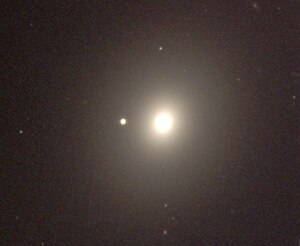Messier 49
| Messier 49 | |
|---|---|
 Galaxy Messier 49 in Virgo | |
| Observation data (J2000 epoch) | |
| Constellation | Virgo |
| Right ascension | 12h 29m 46.7s[1] |
| Declination | +08° 00′ 02″[1] |
| Redshift | 0.003326±0.000022[1] |
| Heliocentric radial velocity | 997±7 km/s[1] |
| Galactocentric velocity | 929±7 km/s[1] |
| Distance | 55.9 ± 2.3 Mly (17.14 ± 0.71 Mpc) |
| Apparent magnitude (V) | 8.4[2] |
| Characteristics | |
| Type | E2,[1] LINER[1] |
| Size | 47.81 kiloparsecs (156,000 light-years) (diameter; 25.0 mag/arcsec2 B-band isophote)[1] |
| Apparent size (V) | 10.2 × 8.3 moa[1] |
| Other designations | |
| NGC 4472,[1] UGC 7629,[1] PGC 41220,[1] Arp 134[1] | |
References: SIMBAD: Search M49 | |
Messier 49 (also known as M49 or NGC 4472) is a giant elliptical galaxy about 56 million light-years away in the equatorial constellation of Virgo. This galaxy was discovered by astronomer Charles Messier in 1777.[a]
As an elliptical galaxy, Messier 49 has the physical form of a radio galaxy, but it only has the radio emission of a normal galaxy. From the detected radio emission, the core region has roughly 1053 erg (1046 J or 1022 YJ) of synchrotron energy.[3] The nucleus of this galaxy is emitting X-rays, suggesting the likely presence of a supermassive black hole with an estimated mass of 5.65 × 108 solar masses, or 565 million times the mass of the Sun (M☉).[4][b] X-ray emissions shows a structure to the north of Messier 49 that resembles a bow shock. To the southwest of the core, the luminous outline of the galaxy can be traced out to a distance of 260 kpc.[5]
This galaxy has many globular clusters: estimated to be about 5,900. This is far more than the roughly 200 orbiting the Milky Way, but dwarfed by the 13,450 orbiting the supergiant elliptical galaxy Messier 87. On average, the globular clusters of M49 are about 10 billion years old.[6] Between 2000 and 2009, strong evidence for a stellar mass black hole was discovered in one. A second candidate was announced in 2011.[7]
Messier 49 was the first member of the Virgo Cluster of galaxies to be discovered.[8] It is the most luminous member of that cluster and more luminous than any galaxy closer to the Earth. This galaxy forms part of the smaller Virgo B subcluster 4.5° away from the dynamic center of the Virgo Cluster, centered on Messier 87.[6][9] Messier 49 is gravitationally interacting with the dwarf irregular galaxy UGC 7636.[5] The dwarf shows a trail of debris spanning roughly 1 × 5 arcminutes, which corresponds to a physical dimension of 6 × 30 kpc.[10]
One supernova has been observed in M49: SN 1969Q (type unknown, mag. 13) was discovered by Evans on 12 June 1969.[11][12][13][14] [Note: some sources incorrectly report the discovery date as 1 June 1969.]
See also
[edit]References and footnotes
[edit]- ^ a b c d e f g h i j k l m "NASA/IPAC Extragalactic Database", Results for NGC 4472, retrieved September 26, 2006.
- ^ "Messier 49". SEDS Messier Catalog. Retrieved April 29, 2022.
- ^ Ekers, R. D.; Kotanyi, C. G. (June 1978), "NGC 4472 – A very weak radio galaxy", Astronomy and Astrophysics, 67 (1): 47–50, Bibcode:1978A&A....67...47E.
- ^ Loewenstein, Michael; et al. (July 2001), "Chandra Limits on X-Ray Emission Associated with the Supermassive Black Holes in Three Giant Elliptical Galaxies", The Astrophysical Journal, 555 (1): L21 – L24, arXiv:astro-ph/0106326, Bibcode:2001ApJ...555L..21L, doi:10.1086/323157, S2CID 14873290.
- ^ a b Irwin, Jimmy A.; Sarazin, Craig L. (November 1996), "X-Ray Evidence for the Interaction of the Giant Elliptical Galaxy NGC 4472 with Its Virgo Cluster Environment", The Astrophysical Journal, 471 (2): 683, Bibcode:1996ApJ...471..683I, doi:10.1086/177998, S2CID 121141029.
- ^ a b Cohen, Judith G.; Blakeslee, J. P.; Côté, P. (August 2003), "The Ages and Abundances of a Sample of Globular Clusters in M49 (NGC 4472)", The Astrophysical Journal, 592 (2): 866–883, arXiv:astro-ph/0304333, Bibcode:2003ApJ...592..866C, doi:10.1086/375865, S2CID 118909977.
- ^ Maccarone, Thomas J.; et al. (January 2011), "A new globular cluster black hole in NGC 4472", Monthly Notices of the Royal Astronomical Society, 410 (3): 1655–1659, arXiv:1008.2896, Bibcode:2011MNRAS.410.1655M, doi:10.1111/j.1365-2966.2010.17547.x, S2CID 119089679.
- ^ Thompson, Robert Bruce; Thompson, Barbara Fritchman (2007), Illustrated guide to astronomical wonders, DIY science, O'Reilly Media, Inc., p. 492, ISBN 978-0-596-52685-6.
- ^ Sandage, A.; Bedke, J. (1994), Carnegie Atlas of Galaxies, Carnegie Institution of Washington, ISBN 978-0-87279-667-6.
- ^ McNamara, Brian R.; et al. (September 1994), "A violent interaction between the dwarf galaxy UGC 7636 and the giant elliptical galaxy NGC 4472", The Astronomical Journal, 108 (3): 844–850, Bibcode:1994AJ....108..844M, doi:10.1086/117116.
- ^ Marsden, Brian G. (June 13, 1969). "Circular No. 2153". Central Bureau for Astronomical Telegrams. Smithsonian Astrophysical Observatory. Retrieved December 2, 2024.
- ^ "SN 1969Q". Transient Name Server. IAU. Retrieved December 2, 2024.
- ^ "NASA/IPAC Extragalactic Database", Results for supernova search near name "NGC 4472", retrieved February 12, 2007.
- ^ Barbon, R.; et al. (1984), "A revised supernova catalogue", Astronomy & Astrophysics Supplement Series, 58: 735–750, Bibcode:1984A&AS...58..735B.
External links
[edit] Media related to Messier 49 at Wikimedia Commons
Media related to Messier 49 at Wikimedia Commons- SEDS: Elliptical Galaxy M49
- Black hole found in a star cluster in M49
- Messier 49 on WikiSky: DSS2, SDSS, GALEX, IRAS, Hydrogen α, X-Ray, Astrophoto, Sky Map, Articles and images

